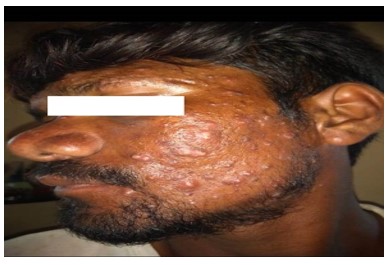Role of Ayurveda treatment protocol in the management of Yuvanpidika w.s.r. to Acne Conglobata – A Single Case Study
DOI:
https://doi.org/10.21760/jaims.9.4.45Keywords:
Youvanpidika, Nitya Virechan, Jalukaavcharan, acne congoblataAbstract
Acne Conglobata refers to the severe form of acne characterized by large polyporous comedon, severe inflammatory lesions including abscesses and cysts, marked scarring and sinus formation. The etiology of acne involves the interplay of multiple factors, including hormonally-induced sebum production, and inflammation. The gram-positive microaerophilic/anaerobic rod called Cutibacterium acnes (formerly Propionibacterium acnes) is a commensal organism of the skin found deep within the sebaceous follicle and mediates a portion of the inflammatory component. In Ayurveda, AC can be correlated with Mukhadushika which was explained under Kshudra Rogas. Due to vitiation of Kapha, Vata and Rakta, small or medium sized eruptions appeared on the face of adolescents. Classical text explains treatment plan for Mukhadushika is of two types Shodhana Chikitsa and Shamana Chikitsa including Vamana, Nasya, Siravedha, Lepa and Pralepa. A 27 year old male patient came with complaints of Pidaka (glandular and papular swelling) all over the face, Todavat Pida (pricking pain) with oiliness of face, Malabadhata (constipation), improper sleep pattern since last 2 months. After detailed examination and history taking Hetu of the disease were evaluated and patient treated with Shodhan and Shaman for 2 months along with Jalukaavcharan 2 times in treatment duration & was also advised to follow Pathya-Apathy. After completion of treatment patient was got relief of all the complaints and get rid of disease.
Downloads
References
Greydanus DE, Azmeh R, Cabral MD, Dickson CA, Patel DR. Acne in the first three decades of life: An update of a disorder with profound implications for all decades of life. Dis Mon. 2021 Apr;67(4):101103. doi: 10.1016/j.disamonth.2020. 101103. Epub 2020 Oct 9. PMID: 33041056.
Garcovich S, et.al, PASH, PAPASH, PsAPASH, and PASS: The auto inflammatory syndromes of hidradenitis suppurativa. Clin Dermatol. 2021 Mar-Apr;39(2):240-247.
Sushruta. Nidansthan, 13/38. In: Shashtri A, editor. Sushruta Samhita. Hindi commentary. Reprint ed., Varanasi: Chaukhambha Sanskrit Sansthan; 2005. p. 282.
Acharya Yadavji Trikamji, Sushrut Samhita, Nidansthan 13/39, Choukhamba publication 2005 Varanasi.
Hagone PA, Kuchewar V. Effectiveness of Mukhaprakshalan by Varun Qwath & Jatiphaladi Lepa in Mukhadushika (Acne vulgaris). International Journal of Ayurvedic Medicine. 2020;11(3):563-67.
Adityan B, Kumari R, Thappa DM. Scoring systems in acne vulgaris. Indian J Dermatol Venereol Leprol 2009;75:323-326
Chavhan MH, Wajpeyi SM. Management of dadru kushta (tinea corporis) through ayurveda-A case study. International Journal of Ayurvedic Medicine. 2020;11:120-23.
Lather A, Gupta V, Bansal P, Sahu M, Sachdeva K, Ghaiye P. An Ayurvedic polyherbal formulation Kaishore Guggulu: a review. Int J Pharm Biol Arch. 2011;2(1):497-503.
Ambhore KP, Misar Wajpeyi SD. Comparative study of Lodhradi Lepa with and without Arogyavardhini Vati in the management of Yuvanpidika. J Indian Sys Medicine 2020;8:21-8.
Pal S, Ramamurthy A, Mahajon B. Arogyavardhini Vati: A theoritical analysis. Journal of Scientific and Innovative Research. 2016;5(6):225-7.
Girbide, S., Sutar, P., & Gudade, S. (2020, September 29). An Ayurvedic Management of Audumbara Kushtha (Psoriasis Vulgaris) - A Case Study. International Journal of AYUSH Case Reports, 4(3), 119-124.
Shekhar M. A literary review on Jalauka-Avacharana (Leech therapy)., The Pharma Innovation Journal 2020; 9(7): 428-431















